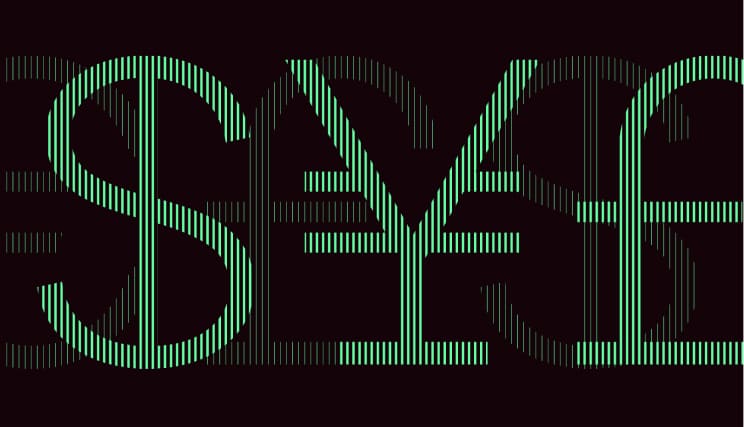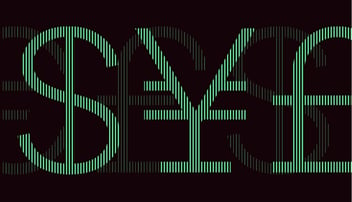Gain an overview of the latest developments on the currency market and anticipate fluctuation risks.
One winner and one loser
Kerplunk! In the end, there is not much good economic news in sight in the eurozone. Activity figures in the services and manufacturing sectors paint the picture of an economy on the verge of recession, whereas the US economy continues to show unexpected resilience. A soft-landing scenario in the US is increasingly credible. In contrast, the eurozone is at the edge of a precipice. If, by some miracle, it dodges a recession this year, it will still not escape a long period of soft growth. This marks a return to the pre-Covid era on the economic front!
The pair of the month
EUR/GBP
High: 0.8689 Low: 0.8513 Change: -0.30%
Sterling is THE currency that needs watching this month, and for two reasons. Firstly, the Bank of England is due to meet on 3 August and there is uncertainty about the scale of future rate hikes (25 or 50 basis points). Secondly, net long positions in sterling are at an historical high. This is never reassuring. There is bound to be a rebalancing sooner or later, and if this happens when the market faces a liquidity crunch, as it does today, this could trigger severe exchange-rate fluctuations. Think about hedging yourself!
EUR/USD
High: 1.1204 Low: 1.0850 Change: +1.35%
The very high volatility of the EUR/USD pair reflects an adjustment of expectations for the eurozone. In the last week of July, the trade-weighted euro exchange rate (a measurement of whether the euro is overvalued or undervalued) suffered its steepest weekly fall since May. This was due to an accumulation of weak statistics in the eurozone. Operators realised they were too upbeat until now about the euro’s prospects. This adjustment could well continue in the short term and lead to a further depreciation of the euro. The true marker for the pair is not the monetary policy differential but the growth outlook differential.
EUR/CNH
High: 8.1184 Low: 7.8436 Change: -0.70%
Since June, the Chinese government, through public banks that have amassed a huge volume of currency reserves, has intervened in the onshore and offshore market to contain the depreciation of the CNH. However, the recent depreciation of the EUR/CNH pair does not reflect these interventions. In reality, the market has probably realised that the euro is a little overvalued in view of the eurozone’s weakened fundamentals. The pair’s ongoing rebalancing could last a few weeks. But the upward trend is still intact in the medium term.
GBP/USD
High: 1.3141 Low: 1.2591 Change: +1.93%
After reaching a monthly high of 1.3141 in July, the GBP/USD pair fell back amid profit taking. The economic and monetary policy backdrop has had little influence on the pair’s trajectory in recent weeks. As long as the cross remains firmly above the support zone of 1.2790, we think there is potential for a strong recovery in the direction of 1.30.
EUR/CHF
High: 0.9823 Low: 0.9688 Change: +0.47%
There was no notable change in this pair. Since the start of the year, we have been expecting the Swiss franc to outperform the euro. This has been the case. Last week, the pair hit its lowest point since September 2022, close to the zone around 0.95. Market operators still have short positions with a new target of 0.9480.
EUR/CAD
High: 1.4872 Low: 1.4382 Change: +1.23%
There was no notable change in this pair compared with a month earlier despite the euro’s technical recovery. The currency market continues to have a long position in the Canadian dollar because of the Bank of Canada’s hawkish tone (in favour of prolonged monetary tightening) and because the Canadian economy is highly exposed to solid demand from the US economy. This last factor is certainly decisive in explaining upward expectations for the Canadian dollar.
EUR/AUD
High: 1.676 Low: 1.6250 Change: +0.83%
The EUR/AUD pair was highly volatile in July, fluctuating within a range of more than 300 pips. Volatility is unlikely to disappear any time soon, as uncertainty surrounding the Reserve Bank of Australia’s meeting on 1 August is unusually high. According to the latest Bloomberg survey, 14 economists expect a rate hike and 11 economists expect a pause. This is hardly a broad consensus. Think of hedging yourself if you are exposed to the Australian dollar!
EUR/JPY
High: 158.05 Low: 151.37 Change: -1.02%
Last week, the Bank of Japan slightly adjusted one of its monetary policy tools – yield curve control (which makes it possible to contain the surge in borrowing costs in the Japanese bond market). However, this failed to convince market operators. The yen fell by 1.4% against the euro during daily trading last Friday. Investors (and this is also our opinion at Ibanfirst) think the Bank of Japan will remain ultra-accommodative for a long time yet. This is negative for the JPY.
EUR/HUF
High: 389.01 Low: 376.84 Change: +3.53%
We do not expect much volatility on the HUF. The EUR/HUF cross should stabilise around the zone between 370 and 385 during the summer and probably most of the rest of the year. Hungarian monetary policy is in automatic pilot mode despite many economic imbalances (high food prices due to a drought, labour shortages, weak labour productivity and highly expansionary macroeconomic policies). This means the base rate should remain around 13% in the short term. In general, any future adjustment to Hungarian monetary policy is announced in advance. This is likely to continue and is a source of stability for exchange rates.
USD/HUF
High: 357.56 Low: 331.40 Change: +2.13%
The upside potential of the USD/HUF pair may be limited by the expected US monetary policy pause, at least until March 2024 (1) and by the related fall in the dollar index (2). The latter may stabilise in the short term around 102. But the market continues to forecast a steeper drop in the second half-year. Unsurprisingly, this runs the risk of having an impact on the USD/HUF.
Economic Calendar
| DATE | CURRENCY | EVENT |
| 01/08 | AUD | Central bank meeting |
| 03/08 | GBP | Central bank meeting |
| 04/08 | USD | Employment figures in the US (July) |
| 10/08 | USD |
Consumer prices in the US (July)
|
| 11/08 | USD |
Production prices in the US (July)
|
|
|
||
| 15/08 | CNH |
Industrial production (July) |
|
|
| 16/08 | GBP |
Consumer prices (July) |
| 18/08 | EUR |
Consumer prices (July) |
|
|
Topics

